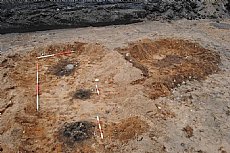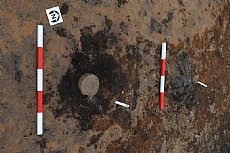Fortrose & Rosemarkie Waste Water Works
01 April 2020
- News Type:
- Site of the Month

An area between Fortrose and Rosemarkie on the Black Isle in Easter Ross was investigated before construction of a Waste Water Works. The site (hereafter called FRWWW) contained a number of pits, Bronze Age and Neolithic, as well as a large Bronze Age grain-drying kiln, a small Bronze Age cremation complex, and medieval and post-medieval pits.

From the Neolithic pits, evidence of grain production included charred wheat, barley, flax and one grain of oats which may have been a weed. Unusually wheat was more prevalant than barley (though there were a number indeterminate grains), and this is one of the few Neolithic sites in Scotland with evidence of flax cultivation. Small quantities of oats were also found. Elsewhere wheat and flax are known from large timber halls such as Balbridie, but no evidence of such a structure was found. The Neolithic pottery showed long use of the site, including Early Neolithic Modified Carinated Bowl, Middle Neolithic Impressed Ware and late Neolithic Grooved Ware. The Carinated bowls were used for cooking. Middle Neolithic Impressed Ware is also known from Kinbeachie on the Black Isle, where, unlike here, settlement remains were found. Charcoal came from alder, birch, hazel and willow, and there was a large amount of hazelnut shells, not unusual for this area or period.
A number of pits were found dating to the Bronze Age, most Middle Bronze Age, usually with a mix of charcoal, hazelnut shell and pottery. Charcoal was similar to the Neolithic, suggesting a largely unchanged landscape. The pottery in the pits were mainly Early Bronze Age beakers, all seemingly funerary types. There were also a few sherds of food vessel pottery. Cists at Rosemarkie Manse and Ness gap also had food vessels. The beaker pottery holds out possibility of Early Bronze Age funerary use at the site.
The grain drying kiln was firmly dated to the Middle Bronze Age (1879-1502 BC), and indicates cereal processing at the site at this time. This is rare find for prehistoric sites. It was primarily used for barley, although a little wheat was found. Interestingly, the barley was mainly naked barley which is more generally associated with Neolithic sites. Large lumps of charcoal suggest some form of drying platform was above the fire pits.

Photo ©RoCAS courtesy HER
The cremation complex also dated to the Middle Bronze Age, and provides evidence for burials at this period. There were five pits, two with urned cremations and two un-urned. The fifth pit only had domestic waste or pyre material. One of the urned pits had an inverted, undecorated urn. The urn is unusual in that it shows an attempt to repair it, again very rarely found. It contained the remains of an individual, probably female, suffering from osteoarthritis in the spine and foot. A copper alloy awl,

and fired clay beads were included with the burial, all of which had been burned in the pyre. These are the first Scottish examples of copying jet styles in clay. It is unusual to find gravegoods from cremation urn deposits, and those form Scotland are generally fairly unprepossessing, with notable exceptions of faience beads from nearby Ness Gap and across the firth at Findhorn.
Many of the details from the burials can be paralleled at nearby Ness Gap (EHG3460), where five cordoned urns were recovered. When this is fully published it will provide a good picture of Middle Bronze Age burial practices on the Black Isle, and a useful comparison to this site. However, it is interesting that charcoal from the funerary pits at FRWWW is dominated by alder, unlike Ness Gap where oak was favoured.

Finally there is evidence of medieval and later use of the site, consisting of four large and one smaller pit. Similar pits are also known from Ness Gap. Metal detecting finds have provided widespread evidence of medieval activity in the Fortrose and Rosemarkie area, both of which were important Medieval ecclesiastical sites, first at Rosemarkie then moving to Fortrose.
The site is important in that it provides well-dated evidence for Middle Bronze Age burials, evidence of corn drying kilns at an early date, early cultivation of flax and use of wheat over barley, and the first evidence of copying jet beads in clay. The area is known for its rich agricultural land (Alasdair Cameron pers. comm.), and was clearly targeted from an early date. The finds of flax, known only in the Neolithic at the large hall sites, is a tantalising hint that a major Neolithic settlement was nearby.
Further information:
Fraser, Lynn 2014 Fortrose and Rosemarkie Waste Water Works, Rosemarkie Road, Rosemarkie. Archaeological Excavation: Final Report, RoCAS, attached to the HER records below:
MHG60799 BA grain drying kiln
MHG60873 Neolithic pit cluster
MHG60800 pit
MHG60801 Pit
MHG60791 Pit cluster
MHG60874 Early Neolithic pit cluster
MHG60875 Urned and Un-urned cremations
MHG60876 post-medieval pits
MHG60877 Pits
Site of the Month Archive
- 10/04/2021 Easter Raitts township
- 02/03/2021 Lower Slackbuie, Inverness (ASDA) Neolithic site
- 01/02/2021 Balnuaran of Clava cairns
- 04/01/2021 Wilkhouse Inn
- 02/12/2020 Spinningdale Cotton Mill
- 02/11/2020 Skibo A Canadian Forestry Camp
- 01/10/2020 WWI Detonator Store, Dalmore near Invergordon
- 03/09/2020 Mesolithic Shell Midden at Sand, Wester Ross
- 08/08/2020 Kinbeachie Neolithic settlement
- 01/07/2020 Armadale Cist Burial and Stone & Timber Complex
